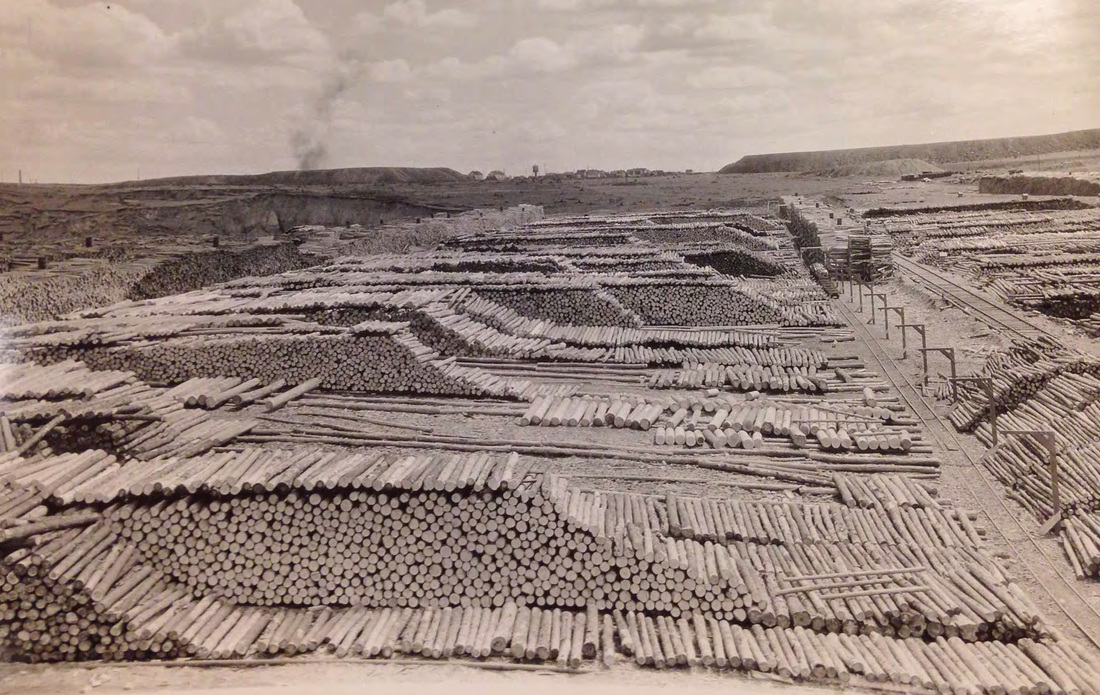|
"A picture is worth a thousand words", or in the case of this image - thousands of trees. It has been over a month since my last blog post - I've been busy working on my dissertation proposal, and recently returned from a really fruitful trip to a handful of archives in Minnesota. I'm still processing much of what I gathered at the archives - (and will be doing so for a number of months) - but I have been dwelling on the image above and what it says about the mining industry: What cultural and environmental impacts of past mining have we forgotten? and What other hidden impacts of mining might we begin to reconsider? The link between deforestation and mining has been discussed at length - for much of mining history, the pick and the axe went hand in hand. Wood was a major requirement of historical mining, it was consumed as a source of fuel, provided mines with building materials, and local timber stands were easily converted into railroad ties and trestles used for transportation. Underground mines also required immense amounts of wood in order to support their subsurface workings. For example, in the underground copper mines of the Keweenaw Peninsula, the quantity of trees required to support the shafts, drifts, and stopes of a single mine were incredible. Historian Larry Lankton describes the underground workings of Calumet & Hecla as a sort of subterranean forest, with the company:"plant(ing) a 'forest' of timber supports or stulls underground each year." (Larry Lankton, Hollowed Ground: Copper Mining and Community Building on Lake Superior, pp. 79) This 'planting a forest' metaphor is powerful since it provides a visual representation of the mining industry's sheer dependence on trees. Underground mining is the type of mining that I most associate with a dependence on wood. These underground mines were selectively extracting ores - surgically removing value and leaving massive voids where an ore used to be - this system required some sort of support structure to hold up the growing underground abyss, and nearby forests provided mines with an accessible and affordable solution to this problem. On the other hand, open-pit mines were exhaustively extracting material, starting from the surface and working both down and out. There were no hanging stopes in open-pit mining, and for the most part, very little concern that the sky was going to start falling. Before uncovering this picture I had correlated that the technological change that gave rise to open-pit mining, also lessened the mine's dependence on forests. While I still believe that this premise is partly right (is it possible that the shift to open-pit mining had a positive impact on forest re-growth?), the image above says otherwise. What other forgotten impacts has mining in the Lake Superior District had on environments and communities, both near and far? The industry relied on coal and coke for much of its fuel, ferrosilicon was an essential component for heavy media separation, and betonite clay was needed for taconite agglomeration. These materials, like the timber in the picture above, are often not in my purview when I reflect on mining heritage, I guess I'm not seeing the proverbial forest for the trees - leading me back to the question: How has the mining of iron ores in the Lake Superior district affected distant environments and communities? I am not entirely sure what the Oliver Iron Mining Co. needed with all of that lumber. I assume that this timber went into building the railroad infrastructure used to move ore within the Leonidas mine, which would have been expanding as the mine grew, but that is just my hypothesis.
What do you think?
1 Comment
|
AuthorJohn Baeten is a Postdoctoral Fellow in Spatial Analysis of Environmental Change in the Department of Geography at Indiana University. He holds a PhD in Industrial Heritage and Archaeology from Michigan Technological University. His research aims to connect historical process to current environmental challenges, and to contextualize the environmental legacies of industrialization as meaningful cultural heritage. Archives
September 2018
|

 RSS Feed
RSS Feed
